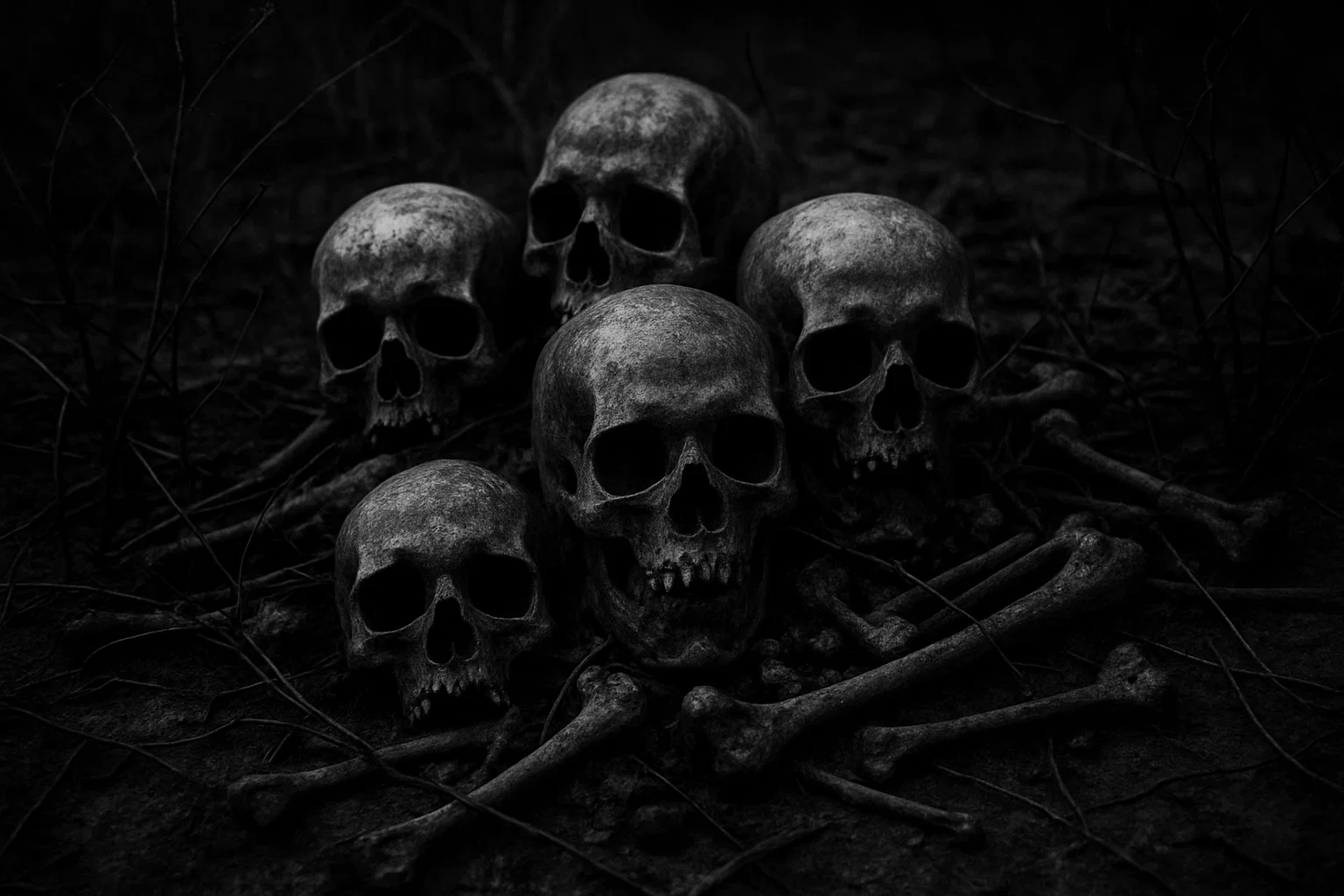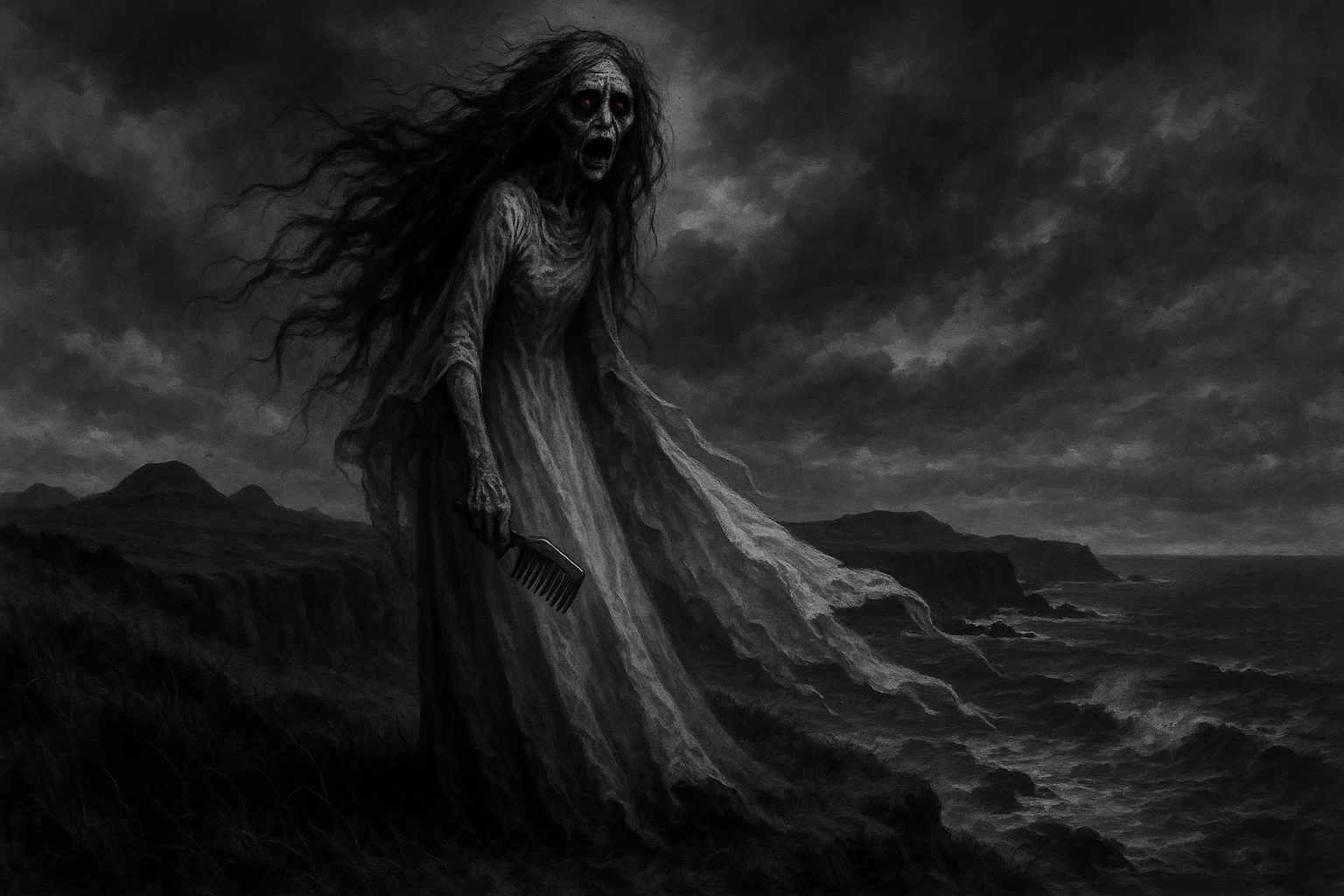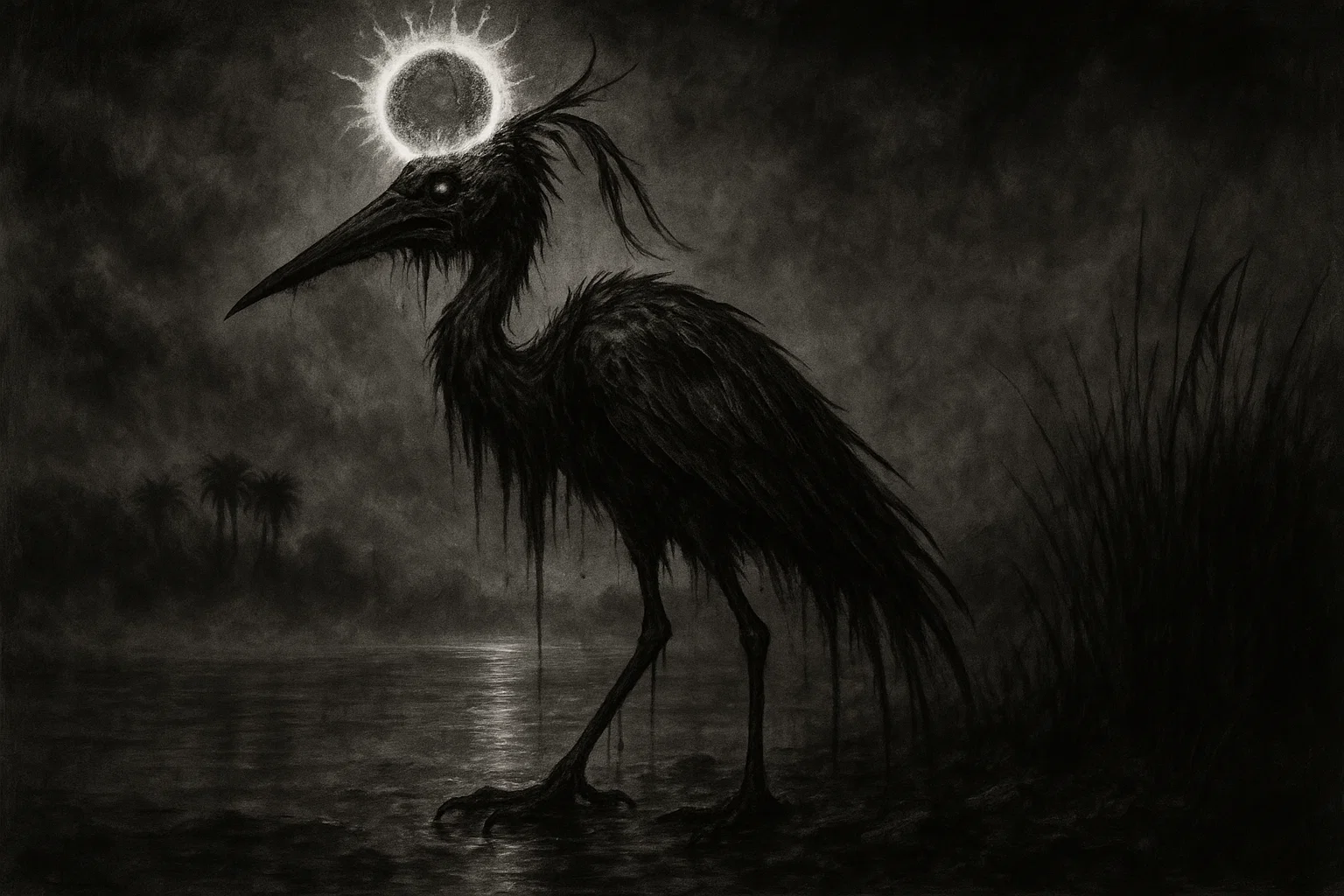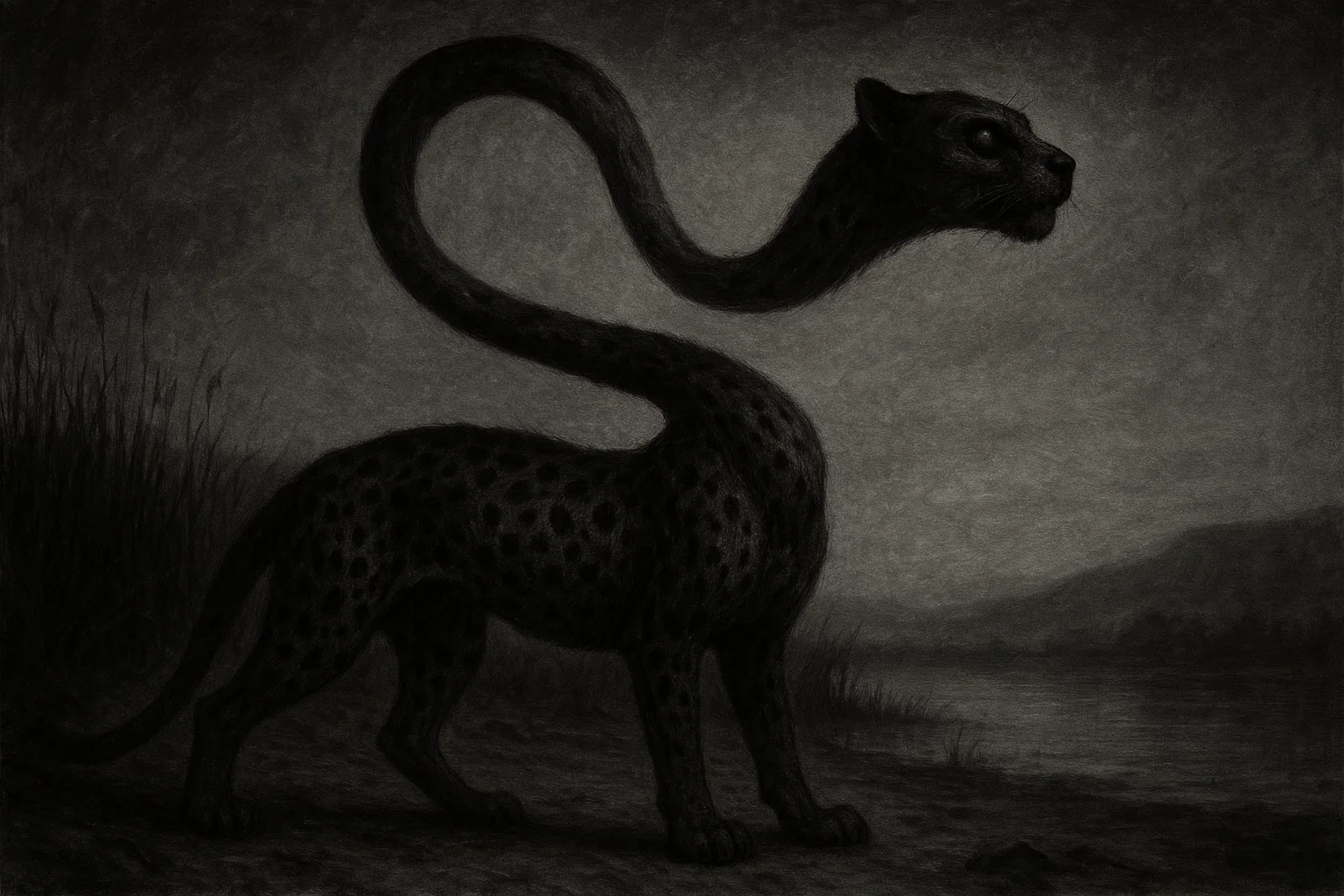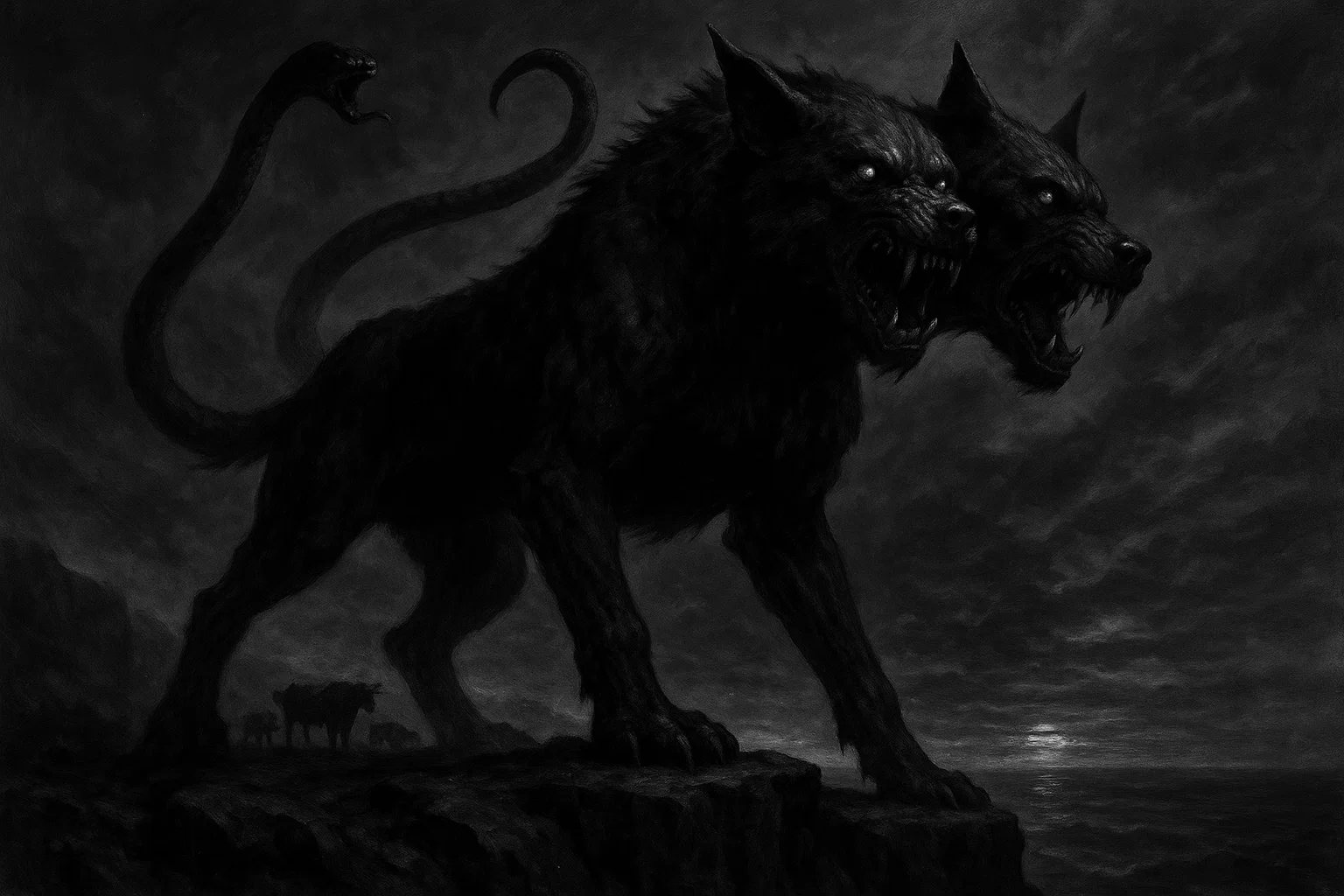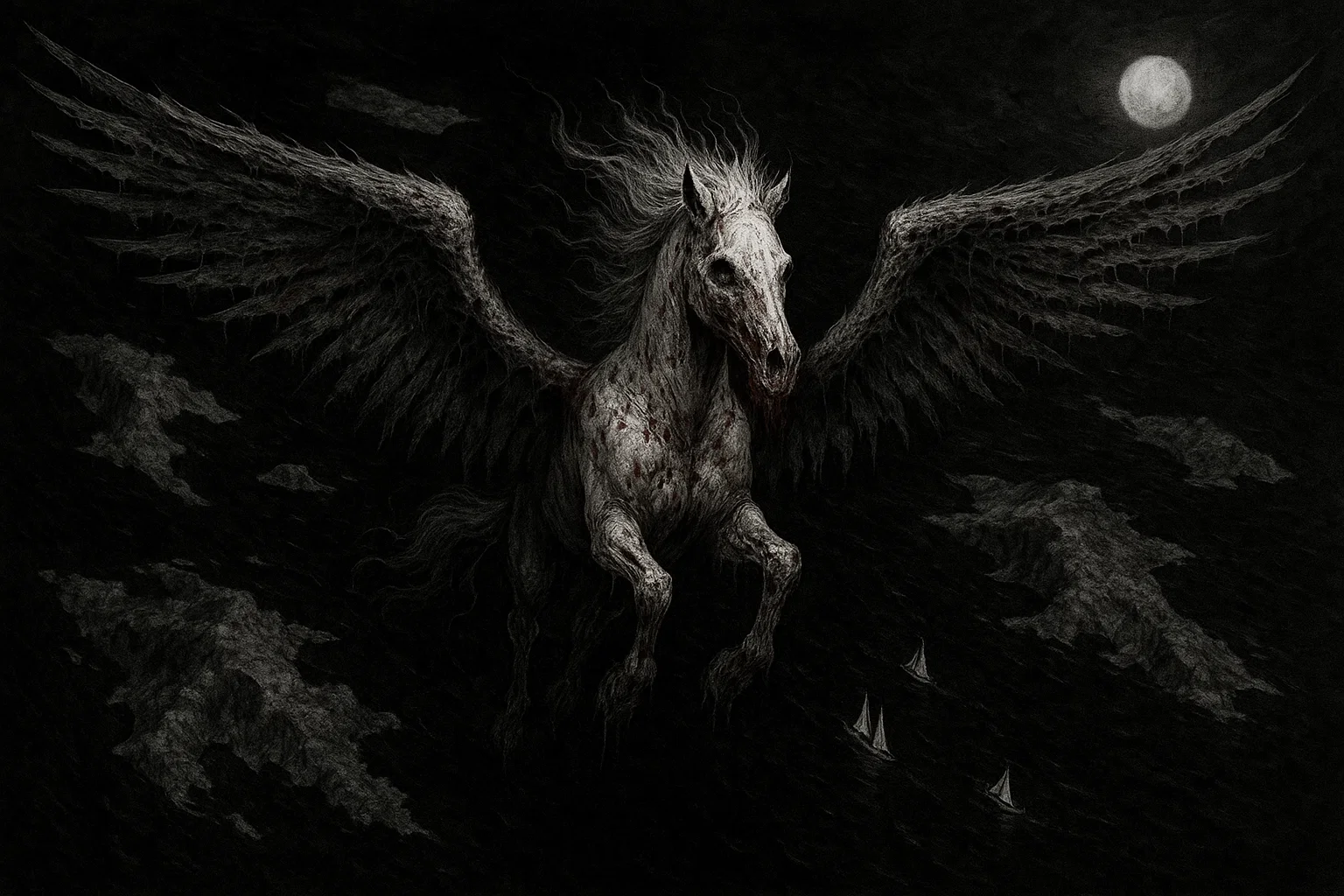The Plymouth plague skulls (also known as the “bones of Plymouth”) are the skeletal remains of Wampanoag villagers from the abandoned settlement of Patuxet, discovered by English Pilgrims in December 1620.
These bones, scattered along the ruins of homes and fields, marked the aftermath of a devastating epidemic known as the Great Dying, which had wiped out nearly the entire population between 1616 and 1619. The Pilgrims, arriving on the Mayflower, repurposed the site as Plymouth Colony, interpreting the desolation as divine providence that cleared the land for their settlement.
This grim discovery, described by Pilgrim leaders as a “hideous and desolate wilderness” littered with skulls and bones, shows how violent the epidemic was, with mortality rates exceeding 90 percent among coastal tribes.
Summary
Key Takeaways
| Attribute | Details |
|---|---|
| Name | Plymouth Plague Skulls; alternative names: Bones of Plymouth, Skeletal Remains of Patuxet |
| Location | Plymouth, Massachusetts, United States (modern-day site of Plymouth Colony, overlooking Plymouth Harbor) |
| History | Devastated by the Great Dying epidemic (1616–1619), which killed 90–95% of the Wampanoag population in Patuxet; village abandoned by 1619; Pilgrims arrived in 1620 and founded colony on the site amid exposed bones |
| Type of haunting | Apparitions; Ghosts (General); Residual |
| Entities | Spirits of deceased Wampanoag villagers from Patuxet, including possible manifestations of Tisquantum (Squanto) and his kin |
| Manifestations | Shadowy figures near burial sites; eerie whispers in Wampanoag languages; cold spots in historical reconstructions; fleeting apparitions of Native figures; unexplained mists over former village grounds |
| First reported sighting | November 9, 1620 (Pilgrims’ initial exploration of Cape Cod graves, prelude to Patuxet discovery) |
| Recent activity | October 2023 (visitor at Plimoth Patuxet Museums reported shadowy figures and whispers during a night tour, echoing Wampanoag oral histories of unrest) |
| Open to the public? | Yes, via Plimoth Patuxet Museums (living history site with guided tours, Wampanoag Homesite, and exhibits on the Great Dying; open year-round with seasonal events) |
What are the Plymouth Plague Skulls?
The “Plymouth plague skulls” are the unburied skeletal remains of the Patuxet people (a band of the Wampanoag Nation) that were uncovered by the Pilgrims upon their arrival in 1620.
These bones lay exposed across the landscape of what was once a thriving village of approximately 2,000 inhabitants, reduced to a ghost town by the Great Dying—a catastrophic epidemic that ravaged coastal New England from 1616 to 1619.
With no survivors around to hold traditional funerals, the remains of people—skulls and bones—were scattered across the land where homes and fields once thrived. This created a chilling scene for those who arrived later.
Alleged hauntings tied to these remains manifest as residual echoes of the tragedy, including apparitions of Native people wandering the site at dusk and faint chants in Algonquian dialects carried on the wind.
Visitors and historians report an oppressive quietude, broken by sudden cold drafts or the sensation of being watched from the shadows of reconstructed homes.
You May Also Like: 15 True Ghost Stories You Shouldn’t Read Alone After Midnight
Plymouth Plague Skulls History
The history of the “Plymouth plague skulls” is indistinguishably bound to the cataclysmic events that transformed the vibrant Wampanoag village of Patuxet into a desolate necropolis, setting the stage for European colonization in New England.
For over 12,000 years, the Wampanoag had stewarded the lands around Plymouth Harbor, with Patuxet serving as a bustling hub of trade, agriculture, and fishing. By the early 1600s, the village supported around 2,000 residents in a network of wetus (domed homes) encircled by fields of corn, beans, and squash.
French explorer Samuel de Champlain documented this prosperity in 1605, sketching a landscape of “a great many cabins and gardens” during his mapping of “Port St. Louis,” as he named the harbor.
The first tragedy struck in 1614 when English captain Thomas Hunt disrupted the balance of life for the local Native American tribes. He docked his ship near a place called Patuxet and tricked Wampanoag men into coming aboard by pretending to offer them a trade. Instead of trading, Hunt enslaved these men, taking 20 from Patuxet and 7 from nearby Nauset villages on Cape Cod.
He transported them to Málaga, Spain, to sell them as slaves. This atrocity sowed seeds of distrust and vulnerability among the tribes. Among the captives was Tisquantum (later known as Squanto), whose absence would spare him from the horrors to come.
The true devastation happened between 1616 and 1619 during the Great Dying, an epidemic of unparalleled ferocity that claimed up to 100,000 lives across Wampanoag, Massachusett, Nauset, and other coastal nations—a mortality rate of 90% to 95% in affected areas.
Ground zero appears to have been Patuxet, where a French fishing vessel wrecked offshore around 1616. According to reports, most of the crew was sick with symptoms of fever, jaundice, and hemorrhaging.
Recent scientific analysis (including studies of ancient DNA from the period) points to leptospirosis—a bacterial infection spread via contaminated water—as the primary culprit. The disease was likely worsened by malnutrition and possibly compounded by secondary illnesses like smallpox or hepatitis.
Unlike the inland Narragansett, who escaped unscathed, coastal groups bore the brunt, as the disease hitchhiked along Abenaki trade routes from Maine to Cape Cod.
The plague’s onset was insidious and merciless. Victims suffered violent fevers, organ failure, and bloody discharges, collapsing in their homes or fields without warning. Entire families perished within days, leaving the dying untended and the dead unburied—a profound violation of Wampanoag spiritual traditions.
Oral histories recount scenes of unimaginable horror: wigwams filled with bloated corpses, rivers choked with bodies, and survivors fleeing inland only to succumb en masse.
In Patuxet, the population plummeted from thousands to zero by 1619, transforming a hub of life into a silent graveyard. Skeletal remains—skulls grinning from doorways, femurs tangled in overgrown gardens—bleached under the New England sun.
When the Mayflower reached the shores on November 9, 1620, carrying 102 weary Pilgrims fleeing religious persecution in England, they first anchored at Provincetown on Cape Cod. The first exploratory parties led by Myles Standish discovered an unusual number of graves. The first signs that something terrible had happened on those lands.
Pressing southward, they reached Patuxet on December 11. William Bradford, the colony’s future governor, chronicled the scene in his 1630 manuscript Of Plymouth Plantation: a “hideous and desolate wilderness, full of wild beasts and wild men,” strewn with “skulls and bones… lying still above the ground where their houses and dwellings had been, a very sad spectacle to behold.”
However, the Pilgrims (half-starved and disease-riddled themselves) viewed this as God’s handiwork, clearing the land for their “errand into the wilderness.” They claimed the village’s cleared fields, tools, and baskets, and started growing English wheat alongside surviving Native stores.
Yet this opportunistic rebirth was built on something dark. Instead of burying the bones with proper rituals, the colonists decided to repurpose them in macabre displays: propped against trees or fences to mimic sentinels.
The exact reason why they did that remains a mystery. Maybe there weren’t enough colonists for such a massive undertaking. Or perhaps they hoped that the bones would deter other Natives from attacking the village. Regardless, the luck wasn’t on the colonists’ side. Half of them perished that first winter from scurvy, pneumonia, and exposure.
In 1621, Tisquantum returned as the last Patuxet survivor. Kidnapped to Spain, enslaved in England, and repatriated via a Jamestown expedition, he found his lands taken by foreign colonists. However, surprisingly, he taught the settlers to fertilize the soil with fish and hunt local game.
Tisquantum also played an important role in the Wampanoag sachem Massasoit’s treaty in 1621, allying with Plymouth against the plague-scarred Narragansett.
However, his death in 1622 from fever—possibly poisoning by rivals—extinguished the Patuxet line entirely.
Years later, the resentments between Natives and colonists erupted in King Philip’s War (1675–1676), during which Wampanoag warriors razed settlements in retribution for land theft.
Today, the “Plymouth plague skulls” evoke not just epidemiological catastrophe but a cascade of human follies—slaving raids, unchecked contagion, and imperial ambition—that buried indigenous futures beneath European foundations.
You May Also Like: 11 Most Haunted Houses in Alabama That Locals Swear Are Truly Possessed
Archaeological Insights and Scientific Analysis
Archaeological investigations at the Patuxet site have provided crucial evidence on the Great Dying epidemic of 1616–1619 and its profound impact on the Wampanoag people.
These studies, conducted primarily through excavations at sites—Burial Hill and the Eel River Farm—use bioarchaeology, paleomicrobiology, and material culture analysis to reconstruct a pre-colonial landscape of thriving indigenous communities reduced to desolation.
Largely managed by Plimoth Patuxet Museums, which holds artifacts from over two dozen local sites, this research underscores the interplay among environmental factors, disease pathology, and cultural continuity.
Ever Walk Into a Room and Instantly Feel Something Watching You?
Millions have used burning sage to force out unwanted energies and ghosts. This concentrated White Sage & Palo Santo spray does the same job in seconds – just a few spritzes instantly lifts stagnation, breaks attachments, and restores peace most people feel immediately.
Skeletal Evidence and Epidemic Pathology
Skeletal remains from Patuxet and surrounding Wampanoag sites provide extraordinary evidence of the Great Dying’s ferocity, though preservation challenges limit direct sampling.
The acidic coastal soils dissolve bones rapidly—often within decades—leaving few intact specimens. However, excavations on Burial Hill in the 1970s and 2010s uncovered fragments—skulls, femurs, and rib cages—interspersed with Pilgrim-era burials, confirming the unburied dead described by early colonists.
These bones exhibit no trauma marks indicative of violence (such as arrow wounds or scalping), but show subtle stress indicators: thinned cortical bone suggesting chronic malnutrition and weakened immunity before the outbreak.
Demographers estimate Patuxet’s pre-epidemic population at around 2,000, part of a Wampanoag confederation numbering 21,000–24,000, reduced by 90–95% in coastal areas, with mass mortality evident in hasty, incomplete burials or none at all.
Scientific analysis points to leptospirosis, a zoonotic bacterial infection (Leptospira interrogans), as the primary pathogen, complicated by Weil’s syndrome in severe cases.
Proposed in a 2010 study in Emerging Infectious Diseases, this hypothesis aligns with symptoms chronicled in Native oral histories and European accounts: high fevers, jaundice, hemorrhagic discharges, and organ failure, with fatality rates up to 42.9% in vulnerable populations.
You May Also Like: Is My Home Haunted or Just Old? How to Tell the Difference
Plymouth Plague Skulls’ Ghosts
| Date | Location | Witnesses | Description | Investigation/Outcome |
|---|---|---|---|---|
| November 9, 1620 | Cape Cod (near Provincetown) | Pilgrims including William Bradford and Myles Standish | Group unearthed Native graves containing skeletons and grave goods; reported a “savage” atmosphere with bones partially exposed, evoking dread. | No formal investigation; Pilgrims took corn and items, interpreting as divine provision; prelude to Patuxet discovery. |
| December 11, 1620 | Patuxet (Plymouth Harbor) | Mayflower exploratory party (Bradford, Standish, et al.) | Encountered village ruins littered with unburied skulls and bones in wigwam doorways and fields; described as a “Golgotha” with overwhelming silence broken by wind through bones. | Documented in Bradford’s journal; site selected for settlement; bones left undisturbed initially, later disturbed during construction. |
| March 1621 | Plymouth settlement | Edward Winslow and other settlers | During early interactions with Samoset, shadows and whispers heard near bone-strewn fields at night; figures glimpsed moving among ruins. | Attributed to “savage spirits” in Winslow’s Mourt’s Relation; no exorcism; Samoset dismissed as natural phenomena. |
| 1970s (exact date undocumented) | Burial Hill, Plymouth | Local historians during excavations | Workers reported apparitions of Native men in deerskin near unearthed bones; cold gusts and chants in Algonquian. | Amateur investigation by Plymouth Antiquarian Society; linked to disturbed remains; reburials performed in 1980s. |
| October 2023 | Plimoth Patuxet Museums | Museum visitor and guide during night tour | Shadowy figures of multiple Native forms seen near Wampanoag Homesite; whispers and mists reported, coinciding with anniversary of Great Dying. | Reviewed by museum staff; incorporated into oral history programs; no scientific study, but Wampanoag advisors noted cultural resonance. |
Initial Discovery of Skeletal Remains (December 1620)
The story of the “Plymouth plague skulls” begins on December 11, 1620, when a small group from the Mayflower, including William Bradford and Captain Myles Standish, ventured into Plymouth Harbor. After weeks of searching along the dangerous shores of Cape Cod, they were looking for a safe place with fresh water and good land for farming.
They landed on a rocky beach and decided to explore inland, only to discover the haunting remnants of a deserted village. The homes (or wigwams) that once buzzed with life were now falling apart, overgrown with plants.
Fields of corn, which should have been cared for, stood wild and untended. But the most chilling sight was the human remains: skulls sitting on doorsteps, rib cages caught in doorways, and bones scattered along the paths where people once walked.
Bradford later described the scene as deeply sorrowful, with the sight of bones reminding him of terrible plagues in the Bible, and the only living creatures being scavenging wolves. The air was thick with the smell of decay, lingering long after the original residents had disappeared. The settlers moved carefully, their weapons ready, fearing what lay ahead.
One of Bradford’s friends, Edward Winslow, shared a memory of a quiet moment when a breeze blew dust from a mound, uncovering even more bones beneath. They noticed untouched baskets and tools, hints that people had left in a hurry.
Soon after, they began building their settlement, gathering wood as they stepped over the remains of the past. Some bones were carelessly pushed aside, while others were crushed underfoot during farming.
You May Also Like: What Are the 14 Types of Hauntings? Everything You Need to Know
The First Apparitions (March 1621)
As winter faded into spring in 1621, the new Plymouth Colony faced challenges just to survive, especially amid unsettling memories of the Plymouth Plague.
On March 22, Samoset (a Wampanoag messenger) approached the settlers, surprising them with his limited English, which he learned from fishermen in Maine. This meeting occurred when Edward Winslow (and other colonists) were already reporting strange occurrences near the burial sites.
Under the night sky, shadows seemed to stretch and twist among the cornfields, forming shapes that looked like people wearing deer skins. When the settlers tried to get closer, these figures would disappear, leaving behind a chilling sense of unease. At night, they could hear whispers, almost like distant drumming, in a language they didn’t understand, which would stop with the first light of dawn.
These bizarre occurrences peaked during Samoset’s three-day stay, during which he shared stories about the Great Dying while they enjoyed meals of succotash.
Winslow wrote about one evening when settlers saw three ghostly figures near a pile of skulls that had been moved to a makeshift burial site. The apparitions appeared faint and shimmering, gesturing southward before fading away into the mist.
Samoset calmly explained that these were manitou—restless spirits of the Patuxet people who had died improperly and whose lands had been disturbed.
Disturbances on Burial Hill (1970s)
In the mid-1970s, archaeological digs on Burial Hill, a spot overlooking Plymouth Harbor, sparked renewed interest in a set of remains (the infamous “Plymouth plague skulls”).
This area, which included the original cemetery of the colony and layers of soil from the Indigenous Patuxet people, attracted teams from the Plymouth Antiquarian Society, especially as construction in the area increased.
On a foggy morning in October 1975, workers excavated a collection of bones from both the Wampanoag people and artifacts from the Pilgrim era. Among the finds was a skull that had strange markings, possibly used in rituals.
As the excavation continued, workers reported a sudden drop in temperature and the ghostly figures—tall Native American men in fringed clothing and feather headdresses—standing watch near the dig site. One of the workers wrote that the figures seemed to multiply, flickering like flames in the breeze.
Along with these sightings came deep, haunting chants that sounded like traditional Algonquian mourning songs. Tools began to fall over on their own, and a faint smell of burning sage filled the air.
The strange occurrences halted work for several days. At night, workers heard knocks on their tents and footsteps on the gravel outside their sleeping quarters.
James Deetz (the lead archaeologist) noted in his journal that these phenomena occurred whenever the bones were disturbed, suggesting they might be linked to a haunting.
To address the situation, Wampanoag consultants were invited to conduct a reburial ceremony in 1977. They scattered tobacco and said prayers to honor the spirits of the deceased.
You May Also Like: Alkonost: The Bird-Woman Monster That Sings You Into Trance
Shadow Figures at Plimoth Patuxet Museums (October 2023)
On October 14, 2023, something unusual happened during a night tour at Plimoth Patuxet Museums.
A group of 12 visitors, including some descendants of the Wampanoag people, was exploring the Wampanoag Homesite (a replica village). As they walked through the exhibits, some visitors began to feel uneasy, especially around a replica wetu (a traditional house).
At about 9:15 p.m., the museum guide unveiled a plaque honoring the victims of the epidemic, and several people in the group began to see strange visions. They described shadowy figures—five in total—appearing to emerge from the trees, as if ink were bleeding into fog.
These figures were said to resemble Native adults and children dressed in traditional clothing. They hovered silently for a moment before moving toward a fire pit, where they seemed to vanish into swirling clouds.
Along with these sightings, some visitors heard soft whispers in the Massachusett language, which a linguist later identified as sad words lamenting those who were not properly buried.
One person even felt a gentle tug on their sleeve, leaving behind what looked like faint, disappearing marks—the kind you might notice when moisture evaporates.
Staff later checked the security cameras, which showed strange light patterns but didn’t capture any figures.
Theories
Scholars, historians, and paranormal investigators have proposed various explanations for the alleged hauntings associated with the “Plymouth plague skulls”, ranging from psychological imprints of collective trauma to environmental factors amplifying folklore.
Residual Haunting from Epidemic Trauma
One prevailing theory posits the apparitions as residual hauntings—non-interactive echoes of intense emotional energy replayed like a historical recording.
Proponents argue that the Great Dying’s scale (with thousands perishing in isolation and without burial rites) imprinted psychic residue on Patuxet’s landscape.
The unburied bones, disturbed by settlers, serve as anchors, triggering replays during anniversaries or excavations. Wampanoag oral traditions support this, describing manitou as bound energies released under specific conditions, such as full moons or site disturbances.
Evidence includes consistent reports of non-responsive figures performing repetitive actions, such as wandering fields and mirroring pre-plague routines.
Psychological Projection of Colonial Guilt
Some people suggest that ghost sightings linked to the “Plymouth plague skulls” might actually be connected to people’s feelings about the past, especially regarding the treatment of Native Americans. As more people learn about the tragic Native history of Native, visitors may start to feel uneasy, which could lead to visions or misinterpretations of what they’re seeing.
This unease is heightened by the focus on the impact of diseases that affected Native populations. It creates a situation in which people’s expectations can lead them to see figures they believe are shadowy Native spirits, representing unresolved historical issues.
Ideas from psychologist Carl Jung support this theory, suggesting that these figures reflect the darker side of America’s founding story.
In fact, there have been noticeable increases in sightings during educational events that discuss the history of genocide. At the same time, security cameras show no unusual activity.
You May Also Like: The 12 Creepiest Halloween Horror Stories Ever Told
Environmental and Infrasound Influences
Environmental factors (particularly infrasound and geomagnetic anomalies) offer a naturalistic explanation for the manifestations associated with the “Plymouth plague skulls”.
Plymouth Harbor’s coastal winds generate low-frequency sounds inaudible to the ear but capable of inducing anxiety, chills, and visual distortions—symptoms mimicking hauntings. Excavations and tidal fluctuations may disrupt underground water flows, enhancing these effects near bone deposits.
Studies from the 2000s—including those by physicist Vic Tandy—link similar phenomena to haunted sites worldwide, with Patuxet’s ley-line proximity (hypothesized energy paths) adding geomagnetic interference.
Plymouth Plague Skulls vs Other Haunted Objects
| Name | Location | Historical Tragedy | Type of Haunting |
|---|---|---|---|
| Amityville Horror House | Amityville, New York, USA | 1974 mass murder of six family members | Demonic; Poltergeist |
| Bell Witch Cave | Adams, Tennessee, USA | 1817–1821 torment of the Bell family | Intelligent; Poltergeist |
| Borley Rectory | Borley, Essex, UK | 1930s fires and suicides post-hauntings | Apparitions; Poltergeist |
| Eastern State Penitentiary | Philadelphia, Pennsylvania, USA | 1829–1971 solitary confinement abuses | Residual; Shadow People |
| Gettysburg Battlefield | Gettysburg, Pennsylvania, USA | 1863 Civil War battle with 50,000 casualties | Apparitions; Residual |
| LaLaurie Mansion | New Orleans, Louisiana, USA | 1830s slave torture and deaths | Intelligent; Demonic |
| Lizzie Borden House | Fall River, Massachusetts, USA | 1892 axe murders of family | Intelligent; Apparitions |
| Myrtles Plantation | St. Francisville, Louisiana, USA | 1800s poisonings and slave deaths | Apparitions; Poltergeist |
| Resurrection Mary | Chicago, Illinois, USA | 1930s hitchhiker death on Archer Road | Crisis Apparitions |
| Stanley Hotel | Estes Park, Colorado, USA | 1910s suicides and accidents | Intelligent; Orbs |
| Tower of London | London, UK | Executions of Anne Boleyn and others (1500s) | Apparitions; Wraiths |
| Whaley House | San Diego, California, USA | 1850s hangings and family tragedies | Intelligent; Ghosts (General) |
| Winchester Mystery House | San Jose, California, USA | 1880s widow’s obsessive building amid deaths | Portal; Thoughtform Hauntings |
You May Also Like: Cadborosaurus: Is the Pacific Northwest Hiding a Sea Serpent?
Is Plymouth Plague Skulls Haunting Real?
The question of whether the hauntings associated with the “Plymouth plague skulls” are truly paranormal remains up for debate. This discussion hinges on a mix of skepticism and strong cultural beliefs.
Historical accounts from places like Bradford and Winslow paint a clear picture of the eerie, skeletal remains in the area, lending credibility to the sadness associated with this site. However, these accounts often interpret the tragedy through a religious lens rather than focusing on ghosts.
In the end, the “reality” of these hauntings might be more about how they connect us to the past and to the deep pain of the Great Dying, a time of great loss.
For the descendants of the Wampanoag people, these spirits represent a call to recognize their history, emphasizing the importance of cultural memory over the need for proof. For others, the heavy toll of history on humanity highlights the need to reflect rather than seek clear answers.

